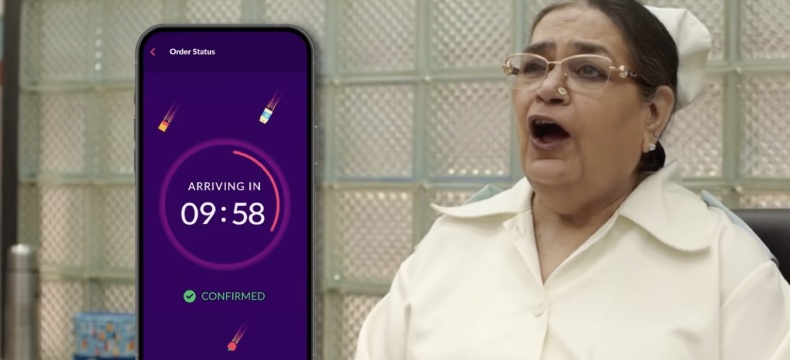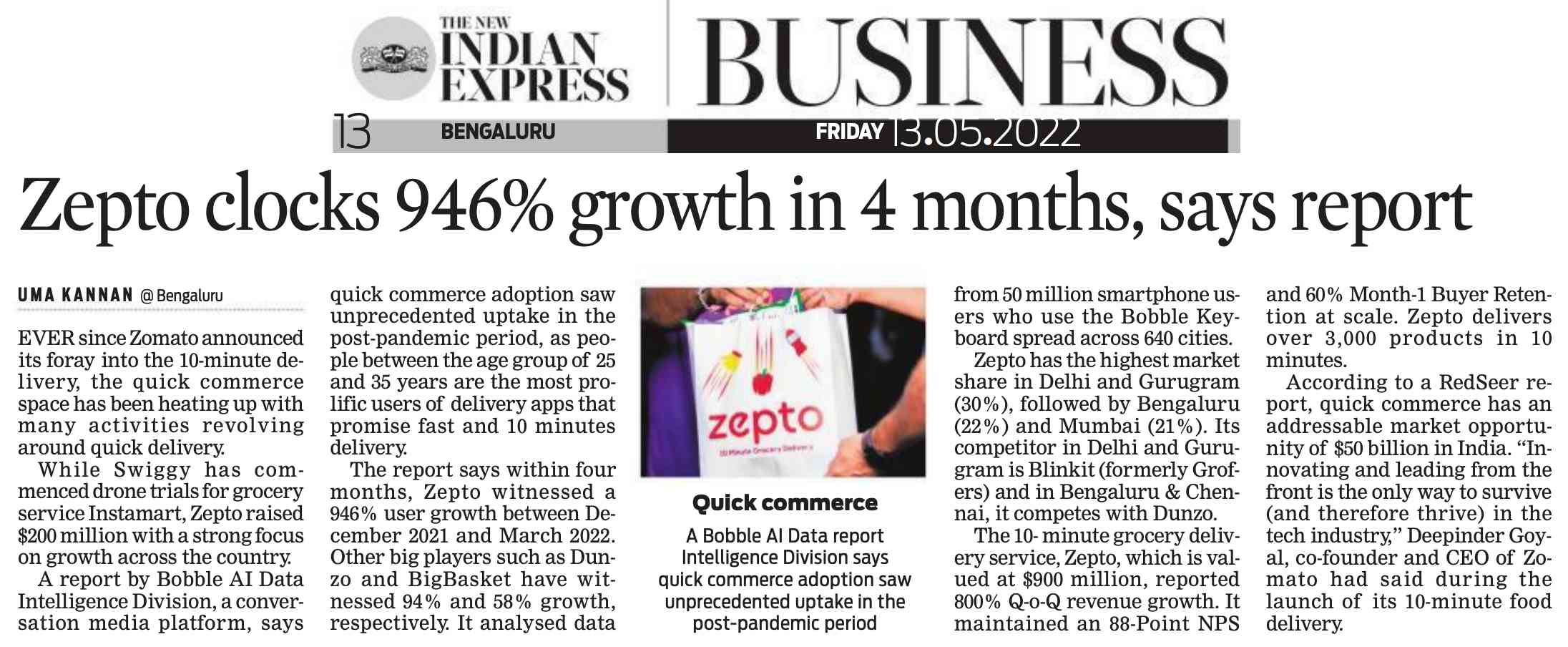
I guess Zepto has caught on to a nice advertising template, concocted by the agency L&K Saatchi and Saatchi. After Kailash Kher and Shankar Mahadevan, here’s the 3rd in the singers-stretching-time series, featuring Usha Uthup. Unlike the earlier two ads, this one has Usha asking a chorus to join her too, and the result is absolutely delightful 🙂
I also recently read that Zepto has clocked 946% growth in the last 4 months!! Of course, this number comes from Bobble AI which has a mobile keyboard and uses key-log data from 50 million users across 640 Indian cities. So the number is not representative of business growth, but usage growth (which should hopefully translate to business as well).

But what is more interesting is how the quick-grocery segment in India is evolving from a marketing communication point of view.
The quick-grocery segment now has a few prominent players: Zepto, Blinkit (formerly Grofers), Swiggy Instamart, and Dunzo Daily.
There are local, city-centric brands like Pickly (that we order from, very often, in Bengaluru, since Zepto is still not available in our area), but from a national marketing perspective, these 4 brands are the ones making the most noise.
Now, consider how the marketing communication narrative for these has evolved over time.
Swiggy has moved from its popular advertising spoof-themed series to the IPL-centric ‘Aap kiske saath dekhoge?’ series. The former is based entirely on the older, popular ads and the need for something instantly was dependent on a specific product being missing in those ads.
But the new series, meant for IPL 2022, is rooted at the home, where the instant need is located.
Blinkit has always located its communication inside the home. A product is being used, it gets over, you need more of it instantly. Blinkit to the rescue.
This was the standard template for Zepto in the beginning; that is, 9 months ago.
Dunzo Daily’s earlier ads, featuring stars like Sunny Deol and Puneeth Rajkumar, were rooted in the home and spoke directly about how other grocery delivery services delay your order.
But the new series about saying goodbye to the fridge is removed from the direct need to order something instantly. That is, the theme leads to an audience insight.
But Zepto goes several steps beyond Dunzo’s out-of-home premise – the new series involving singers is not even located anywhere near the home! The ads are located in a restaurant, an airport, and a hospital! And there is no ordering of products involved at all!
The evolution in communication is this: from talking directly about your instant needs at the home or taking potshots at earlier, now-slower grocery delivery services (that is, simple, linear narratives), the theme is moving towards impressing you about the concept itself – just the ‘ridiculously short time for delivery’ of something.
Why is this significant?
Because this shows that the quick-commerce segment has assumed that the audience education phase is over and that they can move on to more evolved benefit selling.
The audience education phase involved literally informing people that something at the home, that they need urgently, is over, and that they can get it quickly.
The more evolved benefit-selling phase would then completely avoid the above scenarios, and talk merely about the quickness of delivery itself, without focusing on where you need what and why.
That explains Dunzo speaking eloquently about the death of the fridge even though the core idea has a lot of holes (the fridge doesn’t store only groceries or vegetables) and exaggeration needs to be bought into to either understand or appreciate the campaign.
Similarly, Zepto depicts ‘stretching of time’ as an entertaining idea to demonstrate that you don’t need to, anymore.
Both these narratives are quite removed from the ‘we will deliver your groceries very fast’ promise.
I would expect others to catch on to this narrative shift too. For example, I anticipate at least one brand to focus on what you can do with the time you save from walking/driving up to a nearby store to buy groceries yourself.
On a related note, I feel too much is being made out of, ‘Do we really need groceries in 10 minutes? Why can’t you plan your orders better? This fast-everything is killing our earlier way of life…’ and so on.
Whether this 10-minute delivery plan is sustainable or not is a different question, but to say that we don’t need anything in 10 minutes, and ‘what can be delivered in 10 minutes can also be done in 30-40 minutes’ is akin to saying, in the year 2010, ‘if I order online, I’d get it in 2-3 days, but if I go to a nearby store, I’d get it in half a day!’.
We would, eventually, imbibe the service promise of a broad 10-15 minute delivery option for groceries into our lives if the service is sustainable by the very well-financed brands.
Anecdotal example:
1. We think of what to do for breakfast in the morning, at 7 am. No bread at home. Earlier option: walk/drive/ride up to the nearby grocery store and buy bread. Now, we get it via Pickly. It predictably (usually) arrives in about 30 minutes.
2. When we come back from a long’ish trip (say, to Coimbatore), we usually stop at a departmental store near home to buy milk, curd, dosa batter for the evening. Now, we drive straight home and order those via Pickly!
3. If we forget to place our orders for the next day on BB Daily (by 10 pm), we don’t fret anymore 🙂 We simply order them on Pickly the next day morning.
Similarly, on a related note, I used to charge my earlier OnePlus 5T at more predictable, daily schedules because charging used to take time. Now, with the OnePlus 9, I usually let it go down to under 10% charge, and then charge it for about 30+ minutes only quickly because charging is so fast. There was even a time when I used to leave a device to charge for the night to use it during the day (this would be the norm for electric vehicles now, I reckon).
The point is that when something gets done faster, we change our behavior to suit that update. So, instead of going to a store to buy vegetables, we order online. Instead of starting very early to go to a place (through town buses), we start later, depending on the mode of transport (cab). And so on.
Romanticizing on the earlier ways of doing things is usually the norm for a brief period closer to the change, but once a change has settled (like e-commerce, now; or cash payments vs UPI payments), such thought would vanish eventually.
It would be enormously interesting to see how the marketing communication for quick grocery would move forward now. The behavior change is yet to happen on a really large scale in India, but the narrative change has already begun because the brands involved have realized that they are all saying the same thing. The result is the early change by Zepto and Dunzo in differentiating the communication, away from linear, direct narratives, to more evolved benefit selling.
